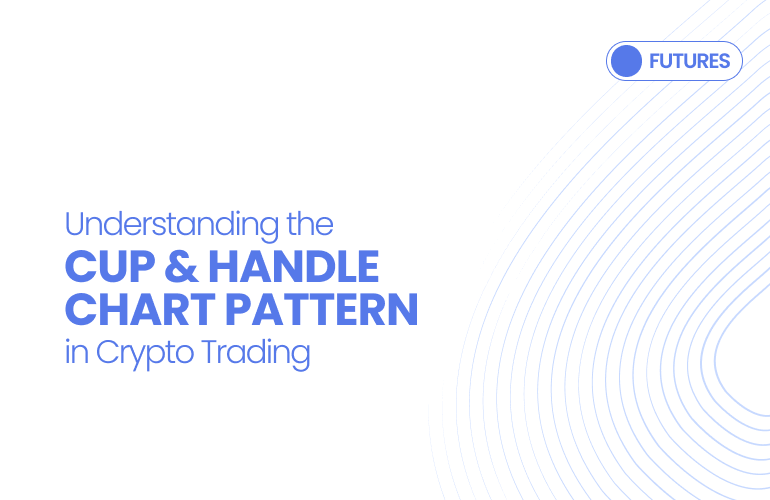If you are learning how to read chart patterns, the cup and handle chart pattern is a must-know setup. Popularised in classical technical analysis, it helps traders spot potential continuation moves after a corrective phase. In crypto, where momentum can build quickly, the pattern offers a structured way to define entries, stops, and realistic targets. Most reputable sources view the cup and handle as a bullish continuation pattern, but context and confirmations influence validity.
What is Cup and Handle Chart Pattern?
A cup and handle chart pattern looks like a rounded “U” (the cup), followed by a mild downward or sideways drift (the handle), and then a breakout above the prior resistance (the cup’s rim). In most texts and exchange guides, it’s described as a bullish continuation pattern that corrects part of a prior uptrend before resuming higher. Traders typically watch for a breakout above the handle’s upper boundary to validate the signal.
Understanding the Cup and Handle Formation
Recognising the cup and handle formation on a price chart is the key to interpreting its trading signal accurately. The formation represents a temporary pause in an existing uptrend, where the market consolidates before gathering strength for the next move higher. By analysing both the cup and the handle, traders can gauge market psychology—from initial correction and accumulation to renewed buying interest.
The Cup Formation
- The cup forms as price slides from a local high, bases in a rounded structure, and climbs back toward the prior peak.
- The bottom is typically curved rather than V-shaped, reflecting a gradual shift from sellers to buyers.
- In traditional literature, the cup can take weeks on higher-timeframe charts; in crypto, formations can compress, but the logic remains: a controlled correction that rebuilds buying pressure.
The Handle Formation
- The handle is a smaller pullback or sideways drift near the rim, often sloping down slightly as weak hands exit and early longs take profit.
- It should not retrace too deeply into the cup; shallower handles tend to be healthier.
- The pattern completes with a decisive breakout above the handle’s resistance, ideally confirmed by higher volume.
Cup and Handle Pattern Rules
Before you trade the cup and handle chart pattern, it is essential to understand the rules that define its validity. These parameters—such as shape, depth, duration, and volume behaviour—help traders distinguish a reliable setup from random market fluctuations. The following points break down the structural and technical factors behind a cup and handle formation.
Identifying a Valid Pattern (Rules for depth, duration, and volume.)
- Prior trend: A preceding uptrend improves reliability.
- Cup depth: Moderate, U-shaped corrections are preferred over very deep or V-shaped drops.
- Handle depth: Generally shallower than the cup; excessive retracement weakens the setup.
- Duration: On higher timeframes, cups often take multiple weeks to form; on crypto intraday charts, proportionate structure matters more than absolute time.
- Volume: Often contracts during correction and expands on breakout, but behavior sometimes varies in volatile markets.
Volume Trends and Breakout Signals
- Decreasing volume through the cup often signals seller exhaustion.
- Increasing volume at breakout suggests participation and conviction, a key filter many traders use to avoid failed breakouts.
Common Pitfalls (Misidentification and over-reliance on the pattern without confirmation.)
- Mislabeling rounding bottoms or saucer bottoms as cups with handles when no clear handle forms.
- Chasing early: Entering before a confirmed breakout and closing above the rim.
- Ignoring confirmation: Skipping volume and momentum checks (e.g., RSI/MACD) can increase false signals.
Trading the Cup and Handle Chart Pattern
Once you can identify a valid cup and handle formation, the next step is executing trades with discipline and precision. This section outlines how to use the pattern in live markets—spotting breakout entry points, setting risk-managed stop-losses, and using technical indicators to confirm trade signals. Together, these practices form a strategic playbook for trading this pattern on Pi42.
Identifying Entry Points
- Classic entry is on a decisive breakout above the handle’s resistance (the cup rim).
- Many traders wait for a candle close above resistance rather than intrabar spikes.
- Conservative traders may add a small buffer above the rim to reduce whipsaw risk.
Setting Stop-Loss and Take-Profit Levels
- Stop-loss: Common placements are just below the handle, low or beneath the cup’s midpoint, depending on your risk tolerance.
- Take-profit: Many traders use cup height for targets, but key resistance zones should guide exits for reliability.
Read More: How to Use Stop Loss & Take Profit in Crypto Futures Trading
Successful trading of cup and handle chart pattern often involves combining this setup with various types of technical indicators. These tools help traders verify breakouts, assess volume quality, and make more informed decisions.
Using Complementary Indicators
- RSI: Look for a shift from mid-range to bullish territory to confirm momentum.
- MACD: A positive cross or rising histogram can corroborate trend acceleration.
- Volume profile / OBV: Can reveal whether accumulation supported the base. Using such tools aligns with exchange education that stresses combining chart patterns with indicator-based confirmation.
Considering the Cup and Handle Chart Pattern
So, is a cup and handle bullish? In most educational resources, the cup and handle candlestick pattern is treated as a bullish continuation setup. For completeness, a few analysts mention inverted cup and handle as bearish, but it is less commonly used than the upward pattern. If you have ever wondered “is cup and handle bullish or bearish?”, the answer depends on which version you’re analysing, the market context, and—critically—your confirmation signals.
Keep Learning:
Options Market-Making in Crypto: Risk Management and Edge Explained
Understanding IV Skew in BTC and ETH Options Markets
Cash-Settled vs. Physically-Settled Options: What Crypto Traders Need to Know

